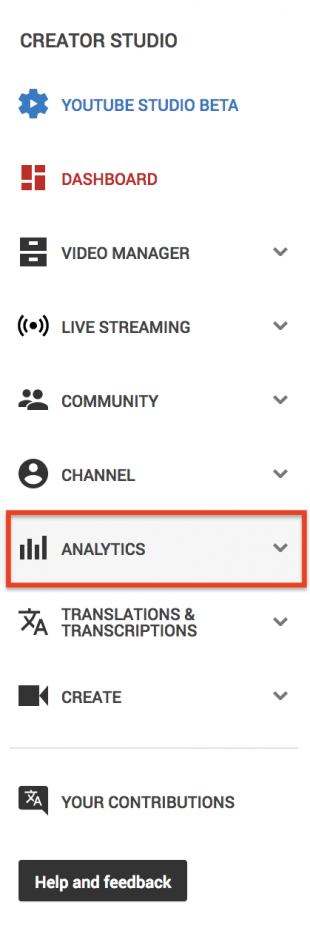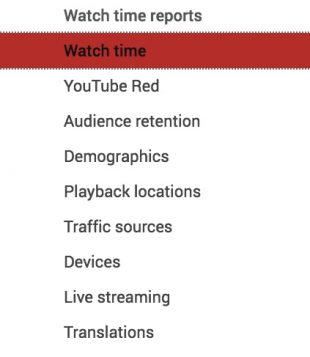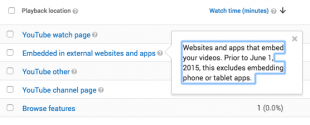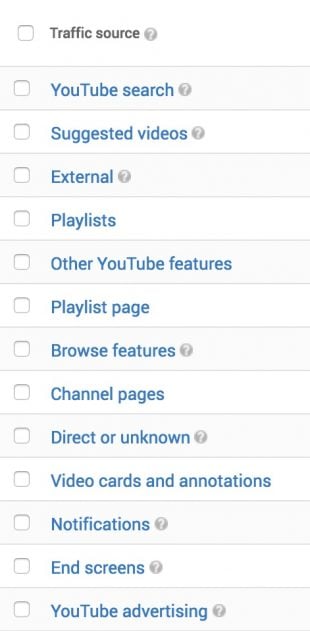Getting to know YouTube analytics is essential if you want to take advantage of your YouTube channel. By quantifying the successes and failures of your videos, you could zero in on opportunities to give value to your subscribers and keep them engaged.
You could also increase your brand’s reach on the web’s second largest search engine.
In this article, we will show you:
- Which metrics you need to prioritize in your YouTube channel analytics, and why
- The difference between vanity metrics and actionable data
- How to select the suitable insights to inform your channel’s development strategy
How to use YouTube analytics
- Log into your YouTube account.
- Click on the profile icon in the upper right, then Creator Studio, next to the cogwheel icon.
- It will bring you to the Creator Studio dashboard—you need to see some basic analytics in the middle of your screen (Watch the time, Views, Subscribers, and Estimated income—more on these later).
- To the left of this panel, you will see a menu. Click on Analytics to navigate to the main YouTube analytics dashboard.
General functions of the YouTube analytics panel
Each analytics page’s Overview header functions drop-down menus on the right. That is where you could narrow down the time period for the data you are examining.
Default settings show the last 28 days, however, you could change them to whatever suits your needs. Relying on the analytics page, you could also filter by continent or country for specific geographical insights.
When you ever want to crunch numbers yourself, you could export datasets as Excel or CSV text files utilizing the Export report button in the upper right.
Lastly, when you are ever confused about what an option means in YouTube, look out for the small grey question mark icon. Click on it to reveal a useful tooltip!
Youtube metrics: What to measure to increase video performance
YouTube video analytics functions three important sections: Revenue reports, Watch time reports, and Interaction reports.
Let’s check out Watch time reports first. That is where you will discover some of the most commonly discussed stats, including watch time, views, and retention.
Watch time reports
The Watch time report compiles data from your YouTube channel, the person videos on your channel, and any engagement from YouTube’s mobile apps.
Right here’s a quick summary of the most important watch time analytics on YouTube, and the questions they answer:
- Watch time: how long are people viewing my videos? How many views do I have?
- Audience retention: how consistently are people seeing my videos? When are people interacting with my content material? When do they stop watching?
- Demographics: who is watching my videos? What countries are my views coming from
- Playback locations: where are people really playing my videos?
- Traffic sources: where are people discovering my videos?
- Devices: what percentage of my views come from a mobile, desktop, or elsewhere?
Watch time and Views
Although Views and Watch time are on the same page, these stats are interdependent. A YouTube video makes one view when it is watched for 30 seconds or longer.
Views are sometimes considered the measure of a video’s success. However, from a marketing standpoint, they are mostly a vanity metric.
(Vanity metrics are numbers which are simply artificially inflated, so they aren’t the most accurate method to measure your channel’s progress.)
Still, when you have a high number of organic views, that means your videos are well-optimized and ranking prominently in YouTube’s search pages—which is good! More importantly, when you divide Watch time by total Views, you get an especially valuable stat: your Average view duration.
Watch time ÷ views = average view duration
Average view duration is an extremely necessary statistic. It could be measured on a per-video basis, or to measure the average amount of time people spend watching videos on your channel as a whole.
In case your videos have a high Average view duration, YouTube’s algorithm will see that you are maintaining eyes glued to their platform. It’ll bump your video higher in the search pages and improve the likelihood that your content material appears in Suggested and Recommended video lists. The more videos you have with high retention rates, the higher your channel will rank.
Audience retention
The Audience retention report videos viewer engagement over time. Right here, you will discover your average view duration stats, a list of your best-performing videos, and insights into how your videos stack up against others on YouTube.
Retention is calculated based on percentage watched: in case your video is a minute long and people watch 30 seconds, the retention fee is 50 %.
YouTube tracks two kinds of audience retention: Absolute audience retention and Relative audience retention. To switch between them, click on a video in the list below the Audience retention graph, then scroll back up to the graph. You will see the filter under the main stats.
Absolute viewers retention
Absolute audience retention exhibits exactly which moments in your videos are most-watched, and where people tend to drop off.
In case you have a high-performing video, take a look at the Absolute audience retention graph to determine the highlights. Pinpointing engagement trends provides you with a greater idea of what your audience wants to see, guiding your content creation efforts.
Similarly, when you have a poor-performing video, the Absolute audience retention graph will show you when people tend to stop watching, so you understand how to adjust.
YouTube recommends paying specific attention to the first 15 seconds of your videos—introductions have the largest drop-off rate. When you are noticing a lack of early engagement, you can:
- Change your thumbnail/video description to more accurately reflect your video
- Remove or shorten a long introduction
- Grab attention by addressing your video topic immediately
Relative audience retention
Right here’s where you compare your video’s retention fee to all other YouTube videos of similar length.
Because this comparison is only based on duration and does not factor in content, it is a less helpful statistic than Absolute audience retention. It does, but give a general point of comparison between your content and other videos on YouTube.
Demographics
To find out about the people watching your videos—particularly, their age, gender, and geographical location—check demographics. Getting to know your audience could help you make more informed, targeted advertising and marketing decisions. Or it could help you tap into markets you had not considered previously.
Let’s say you are a UK-based YouTuber who makes videos about building custom computer rigs. You take a look at analytics, expecting to discover a core demographic of 18 to 24-year-old men, however, uncover your audience is actually female-identified people in the US aged 65 and older.
Armed with this data, you can adjust the tone of your videos to win back your expected demographic, pivot to your newly-discovered viewers, or search for a method to please everybody.
Appealing to demographics is necessary for winning subscribers. They will watch twice as much of your video content as people who are simply passing through.
Playback locations
Playback locations show you where your content material is being watched within the YouTube platform, or elsewhere online.
If you want to check traffic from outside YouTube’s pages, scroll down to the list under the graph and click on Embedded in external sites and apps. This will bring up a list of all the locations your videos have been watched within the selected date range.
Finding out the place your videos are being played permits you to optimize your advert spend on these locations, providing you with the most reach for your money. You also get insight into your audience’s browsing and watching habits, which can even open doors for new marketing outreach partnerships.
Traffic sources
Right here’s where you will learn how people are finding your videos.
Each item in the list under the graph could be clicked on to reveal particular info within that category.
Did somebody find you by using a particular search term? Are you getting a traffic increase after featuring in a prominent YouTuber’s playlist? These are the questions these metrics could help you answer.
Examining traffic sources data provides you with a more detailed sense of your channel’s reach, whether you are taking a look at stats related to paid traffic (e.g., YouTube adverts), or organic traffic, (e.g., YouTube’s suggested videos function). (TBC)






